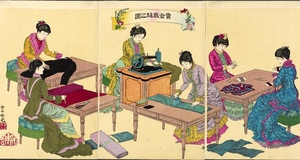A Contrast of Issei and Nisei as Illustrated by King-Kok Cheung, Hisaye Yamamoto, and Emiko Okori
By
2009, Vol. 1 No. 10 | pg. 1/1
KEYWORDS:
Hisaye Yamamoto’s double-telling stories, according to King-kok Cheung, convey “two tales in the guise of one,” one woven from the explicit words of the narrator, the other from the softened and sometimes pointedly silent characters that surround the narrator (Cheung, 29). However, Yamamoto’s double-tailed method not only exhibits the muted voices of the Issei, but the dichotomies of these immigrant-internees’ lives in America, sharply divided across lines of gender, race, generation, and citizenship. The Issei had to raise their children in a “free prison,” where women are still bound by centuries-old rituals of submission, men are emasculated and completely stripped of the power they once possessed, and the Nisei grew farther and farther apart from their parents, stray children who did not have the capability to deal with the aftershocks of being driven into internment camps. The women in Yamamoto’s stories practice enryo, a mode of deference and reserve valued in Japanese etiquette. As women in Japan, they are taught to submit to the word of their husbands or any other man so that the concepts and roles of man and woman remain constant. Despite the translocation from Japan to the United States, and from their homes into concentration camps, Issei women did not break this rule of their homeland’s culture – as good rice and green tea were imbedded in the palates of the Nisei, silence and deference were in the very nature of female Issei. Emiko Omori says of her mother, “I always remember her walking three paces behind my father” (Rabbit in the Moon). In Yamamoto’s stories, women only break this crippling silence through grave warnings, directed at their children, of horrible events that these dual cultures of extreme suppression have forced upon them. Still, so muted are they that these events are never overtly explained to the children – the reality of their lives is never candidly expressed to the Nisei, a factor that may have driven many Japanese-American children away from a close maternal bond. As the women practiced enryo, Japanese men interned in the United States were bound by the culturally-displacing tradition of gaman. As stoic as women were forced to be, the men in Yamamoto’s tales “seem inordinately reinforced by the politics of race as well as by cultural rules… that socialize them to practice ‘silent protest’” (Cheung, 49). The fathers in all of Yamamoto’s stories are voiceless throughout most of the narratives. Mr. Hayashi explodes in a fit of bottled rage; Mr. Hosoume remains silent, dejected and trapped in his own home; and Rev. Sasagawara is barely present. Mr. Hosoume’s impotence, in particular, is a stark and obvious symbol for the male Issei’s loss of agency, in the new world of prison camp America. A man’s capacity to act upon his environment and better it for himself and his family is a mark of strength and masculinity in both Japanese and American cultures. With the government stripping away his home and property, and the chance of a male heir gone, Mr. Hosoume has lost that masculinity, and submits to American tyranny. The young, handsome editor who shows interest in Mrs. Hayashi’s “Seventeen Syllables” threatens Mr. Hayashi’s place at the head of his family. Mrs. Hayashi “shifts easily into his style” (50), which may mean something important to her husband, who knows of her “immoral” past. His violent response is one-dimensional – he destroys because he, through the practice of gaman, is incapable of conveying emotion.The Nisei, children of the Issei whose cultural thought processes are more American than Japanese, are the ones left behind in the aftermath of the internment camps. Without mothers who can speak, without fathers who can express themselves, they are left stranded and contradicted by a culture that outwardly values individuality and protest, but at the same time imprisoned them for the way their faces looked. Yamamoto has commented on the warring dual nature of the Nisei: “For a writer proceeds from a compulsion to communicate a vision and he cannot afford to bother with what people in general think of him. We Nisei… care very much what others think of us” (30). I believe this stands for men as well as women – each Nisei has two versions of one story, one Japanese and one American, one masculine and one feminine, one overt and one covert. As muted as they sometimes feel, their stories, critical to the American perspective on history, culture, and human rights, ought to be told – they can be great storytellers.
Cheung, King-kok. Articulate Silences. Ithaca; Cornell University Press, 1993. Rabbit in the Moon. Dir. Emiko Omori. Videocassette. New Day Films, 1999. Yamamoto, Hisaye. “Legend of Miss Sasagawara” and “Wilshire Bus,” from Seventeen Syllables. New Brunswick: Rutgers University Press, 1998. Suggested Reading from Inquiries Journal
Inquiries Journal provides undergraduate and graduate students around the world a platform for the wide dissemination of academic work over a range of core disciplines. Representing the work of students from hundreds of institutions around the globe, Inquiries Journal's large database of academic articles is completely free. Learn more | Blog | Submit Latest in Literature |
















